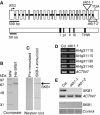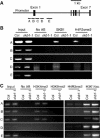SKB1-mediated symmetric dimethylation of histone H4R3 controls flowering time in Arabidopsis
- PMID: 17363895
- PMCID: PMC1847673
- DOI: 10.1038/sj.emboj.7601647
SKB1-mediated symmetric dimethylation of histone H4R3 controls flowering time in Arabidopsis
Abstract
Plant flowering is a crucial developmental transition from the vegetative to reproductive phase and is properly timed by a number of intrinsic and environmental cues. Genetic studies have identified that chromatin modification influences the expression of FLOWERING LOCUS C (FLC), a MADS-box transcription factor that controls flowering time. Histone deacetylation and methylation at H3K9 and H3K27 are associated with repression of FLC; in contrast, methylation at H3K4 and H3K36 activates FLC expression. However, little is known about the functions of histone arginine methylation in plants. Here, we report that Arabidopsis Shk1 binding protein 1 (SKB1) catalyzes histone H4R3 symmetric dimethylation (H4R3sme2). SKB1 lesion results in upregulation of FLC and late flowering under both long and short days, but late flowering is reversed by vernalization and gibberellin treatments. An skb1-1flc-3 double mutant blocks late-flowering phenotype, which suggests that SKB1 promotes flowering by suppressing FLC transcription. SKB1 binds to the FLC promoter, and disruption of SKB1 results in reduced H4R3sme2, especially in the promoter of FLC chromatin. Thus, SKB1-mediated H4R3sme2 is a novel histone mark required for repression of FLC expression and flowering time control.
Figures





References
-
- Alonso JM, Stepanova AN, Leisse TJ, Kim CJ, Chen H, Shinn P, Stevenson DK, Zimmerman J, Barajas P, Cheuk R, Gadrinab C, Heller C, Jeske A, Koesema E, Meyers CC, Parker H, Prednis L, Ansari Y, Choy N, Deen H, Geralt M, Hazari N, Hom E, Karnes M, Mulholland C, Ndubaku R, Schmidt I, Guzman P, Aguilar-Henonin L, Schmid M, Weigel D, Carter DE, Marchand T, Risseeuw E, Brogden D, Zeko A, Crosby WL, Berry CC, Ecker JR (2003) Genome-wide insertional mutagenesis of Arabidopsis thaliana. Science 301: 653–657 - PubMed
-
- Ancelin K, Lange UC, Hajkova P, Schneider R, Bannister AJ, Kouzarides T, Surani MA (2006) Blimp1 associates with Prmt5 and directs histone arginine methylation in mouse germ cells. Nat Cell Biol 8: 623–630 - PubMed
-
- Ausin I, Alonso-Blanco C, Jarillo JA, Ruiz-Garcia L, Martinez-Zapater JM (2004) Regulation of flowering time by FVE, a retinoblastoma-associated protein. Nat Genet 36: 162–166 - PubMed
-
- Bao S, Qyang Y, Yang P, Kim H, Du H, Bartholomeusz G, Henkel J, Pimental R, Verde F, Marcus S (2001) The highly conserved protein methyltransferase, Skb1, is a mediator of hyperosmotic stress response in the fission yeast Schizosaccharomyces pombe. J Biol Chem 276: 14549–14552 - PubMed
-
- Bastow R, Mylne JS, Lister C, Lippman Z, Martienssen RA, Dean C (2004) Vernalization requires epigenetic silencing of FLC by histone methylation. Nature 427: 164–167 - PubMed
Publication types
MeSH terms
Substances
LinkOut - more resources
Full Text Sources
Molecular Biology Databases
Research Materials

